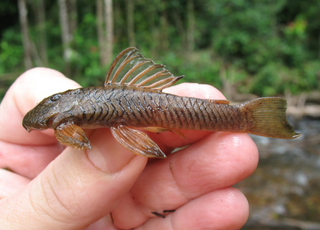
The Cetopsidae are a small family of catfishes, commonly called the whale catfishes.

The stream catfishes comprise the family Akysidae of catfishes.
This glossary of ichthyology is a list of definitions of terms and concepts used in ichthyology, the study of fishes.

Phreatobius is a genus of very small catfishes from tropical South America.

Auchenipterichthys is a genus of driftwood catfishes found in South America.

Helogenes is a genus of whale catfish found in tropical South America.
Cetopsidium is a genus of catfishes of the family Cetopsidae.

Paracetopsis is a genus of whale catfishes found in tropical South America.

Cetopsis is a genus of catfishes of the family Cetopsidae.
Synodontis polli, known as Poll's synodontis, is a species of upside-down catfish endemic to the Democratic Republic of the Congo, Burundi, Zambia, and Tanzania, where it is only known from Lake Tanganyika. It was first described by Belgian ichthyologist Jean-Pierre Gosse in 1982, from specimens collected at multiple points along the shore of Lake Tanganyika.

Entomocorus is a genus of catfishes of the family Auchenipteridae.
Denticetopsis praecox is a species of whale catfish endemic to Venezuela where it is known from the Baria River of the upper Rio Negro basin. This species grows to a length of 5.3 cm.
Denticetopsis royeroi is a species of whale catfish endemic to Venezuela where it is only known from the holotype collected in a tributary to the upper Rio Negro. This species grows to a length of 1.8 cm.
Denticetopsis seducta is a species of whale catfish endemic to Brazil where it has a relatively wide, albeit scattered, distribution in the central and western portions of the Amazon basin and possibly the southwestern portions of the Orinoco River basin; it is relatively disjunct from the other species of Denticetopsis. It grows to a length of 5.1 cm.

Synodontis multimaculatus, known as the dotted synodontis, is a species of upside-down catfish that is native to the Democratic Republic of the Congo where it is found in the Ubangi River. It was first described by British-Belgian zoologist George Albert Boulenger in 1902, from a specimen collected in the Ubangi River in Mobayi-Mbongo, the Democratic Republic of the Congo. The species name multimaculatus is derived from the word multi, meaning many, and the Latin word maculatus, meaning spots, referring to the many spots on the fish.
Synodontis lucipinnis is a species of upside-down catfish endemic to Zambia, where it is only known from the Musende Rocks area (Mpulungu) of Lake Tanganyika. It was first described by Jeremy John Wright and Lawrence M. Page in 2006. The species name "lucipinnis" is derived from a combination of the Latin luci, meaning bright or clear, and the Latin pinnis, meaning fin. This refers to the light coloration in a patch on the base of the fins of this species.
Astyanax microschemos is a species of characid fish from Brazil. It belongs to the A. scabripinnis species complex and differs from other species outside it by having a lower number of branched anal fin rays and its shallow body depth being about 26.9-29.7 vs more than 35% of its standard length (SL). Compared to species of its own complex, it can be distinguished by the combination of its shallow body depth, and smaller interorbital width. The species name comes from the Greek mikroschemos, meaning "low stature", which refers to the shallow body depth of the animal.
Deuterodon pelecus is a species of characid fish from Brazil. It can be distinguished from other species by: its body depth ; its short and pointed snout smaller than the orbital diameter; and a reduced number of branched anal fin rays. D. pelecus also differs from members of its genus by its characteristic color pattern. It possesses a single humeral spot that is constricted to the region above the lateral line; at the same time it shows a conspicuous midlateral body stripe from opercle to the caudal fin base, an autapomorphy of this precise species. Other Deuterodon species have a humeral spot that is vertically or horizontally elongate and have the midlateral stripe becoming faint near that humeral spot. The species name is derived from the Greek pelekus, meaning "axe", referring to the pigmentation shape resulting from the adjoinment of the humeral spot with the midlateral stripe.

Guyanancistrus nassauensis is a species of catfish belonging to the family Loricariidae, the suckermouth armored catfishes. It is discovered in 2005 and formally described in 2018. G. nassauensis is a rare species, highly endemic to the Nassau Mountains in Suriname, and is threatened with extinction by proposed or ongoing mining activities.

Cetopsis candiru, also known as candiru, candiru açú, candiru cobra or canero, is a carnivorous species of whale catfish found in the Amazon basin of Peru, Brazil and Bolivia. Similar to Cetopsis coecutiens, Cetopsis candiru is a large species of the genus Cetopsis and a widespread scavenger, known for its voracious feeding and the habit of burrowing into the carcasses of dead animals and humans. Despite its name, it is not closely related to the bloodsucking Candiru.









